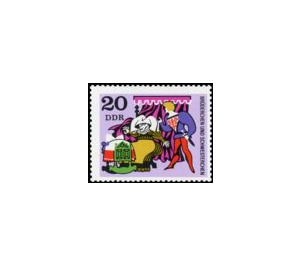Fairy tale: little brother and sister - Germany / German Democratic Republic 1970 - 25 Pfennig
Theme: Animals
| Country | Germany / German Democratic Republic |
| Issue Date | 1970 |
| Face Value | 25.00 |
| Color | multi-colored violet |
| Perforation | K 13 1/2: 13 |
| Printing Type | offset |
| Stamp Type | Postage stamp |
| Item Type | Stamp |
| Chronological Issue Number | 1291 |
| Chronological Chapter | GER-DDR |
| SID | 307793 |
| In 17 Wishlists | |
German Fairy Tales, Edition 1970 The Ministry of Posts and Telecommunications of the German Democratic Republic publishes six multi-colored special postage stamps with illustrations from the German fairytale "Brothers and Sisters". The six stamps are printed on a miniature sheet. No special first-day cover envelope Brothers and Sisters "Brothers and Sisters" is probably one of the most popular children's and house fairy tales of the Brothers Grimm. As with many folk tales, there are also different versions of "Brothers and Sisters". In the Grimm's collection, two variants appear, both of which come from the Marie in the Wildschen home to Kassel and were told in the Maingegenden (1). The original version of March 10, 1811 appeared in the first edition of 1812. Also mentioned in the appendix of this edition, another fragmentary version in which the little brother is turned into a gold deer (2). Only in a later edition (1819) appears a revised version, as it is mostly known today. The Kinderbuchverlag in the German Democratic Republic also publishes this revision, as it is the richer of the two versions. It is based on this special postage stamp output. At first the king is deceived, but at night the nurse notes a figure who speaks to the child and the deer. That's what she tells the king. He recognizes his right wife (25 pfennig value). The original version lacks some decorative details and the fact that the deer jumps into the hunt. The king discovers the girl with the deer when he gets lost in the forest. Also the final formula does not agree literally. Another version, by H. R. v. Schröter communicated to the Brothers Grimm probably comes from the Hannoversche. The sister is turned into a duck by the stepmother and only recognized by the cook, who reveals the fraud (4). In countless variations there is this motif in the fairy tales of almost all European, many Asian, even some African peoples. The value of this fairytale lies in the ethical-moral area. Justice triumphs: wickedness, condescension and resentment are punished. (1) After comments on the children's and house fairy tales of the Brothers Grimm. Newly edited by J. Bolte and G. Polivka, Vol. 1. Dieterisch'sche Verlagsbuchhandlung, Leipzig, 1913. (2) Children's and Household Tales of the Brothers Grimm. Complete edition in the original version. Edited by F. Panzer. Vollmer Verlag, Wiesbaden. (3) The children's and house fairy tales of the Brothers Grimm. Children's book publisher, Berlin. Selected by Dr. med. A.Kocialek. (4) Notes on the children's and house fairy tales of the Brothers Grimm. Newly worked by J. Bolte and G. Polivka, Bd. 1. Dieterisch'sche Verlagsbuchhandlung, Leipzig, 1913.


